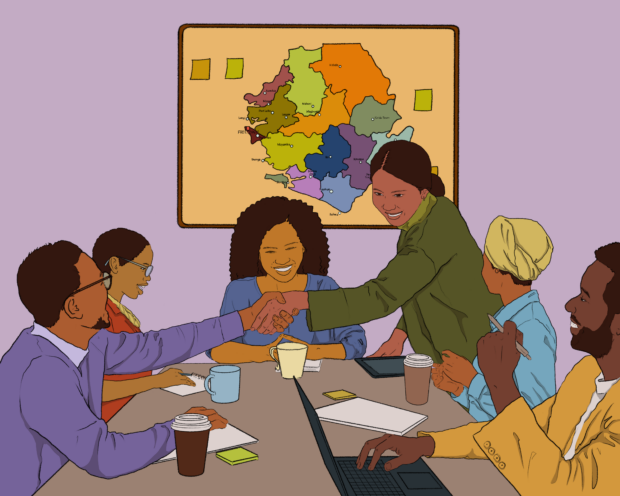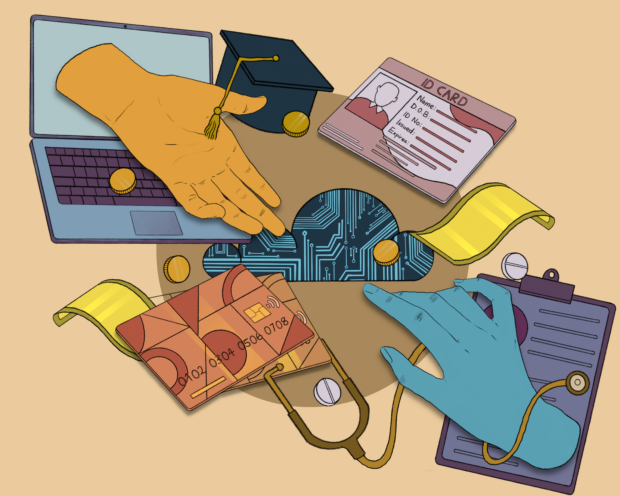A landmark moment unfolded at the Global AI Summit in Rwanda – the adoption of the Africa Declaration on Artificial Intelligence. The Declaration, which established a new Africa AI Council and is signed by 54 countries and the African Union, marks a bold step forward in the continent’s digital transformation journey. The declaration recognizes the transformative power of artificial intelligence (AI) and aims to position Africa as a global leader in ethical, trustworthy, and inclusive AI adoption.
To realize the objectives within this declaration, the interplay between AI and digital public infrastructure (DPI) presents unprecedented opportunities. These two transformative technologies have the potential to work symbiotically, creating solutions that address uniquely African challenges while leveraging the continent’s strengths. However, ensuring that Africa shapes its own AI development journey and that these technologies deliver meaningful benefits to people will require deliberate efforts and careful consideration of critical factors.
Together, DPI and AI can be transformative – but only if they are designed to maximize public benefit.
Firstly, is it ‘DPI for AI’, or ‘AI for DPI’? In truth, both.
A DPI approach to a country’s digital infrastructure lays the foundations upon which AI can operate effectively – enabling trusted transactions while generating vast amounts of data to improve AI models. At the same time, there is potential for AI to enhance DPI by making these systems more intelligent, responsive, and personalized to African contexts – through improved fraud detection, optimizing usage patterns, and by helping data, ID, and payments systems to seamlessly operate in multilingual contexts. And, as these systems increasingly interplay, there will be new benefits not yet imagined, particularly if both DPI and AI are built on open-source technology that allows users to continually iterate, customize, and improve upon core digital systems.
When working in harmony, we expect these technical approaches to drive remarkable progress: creating new employment opportunities, improving healthcare delivery, and strengthening climate resilience. And yet, from our work on effective digital transformation in Africa over the past decade, we know that good digital technology doesn’t automatically drive inclusion or positive outcomes for people. These technologies must be designed, deployed, and governed with people at the center.
To ensure that AI and DPI can be leveraged in tandem to drive a positive digital future, we look to our work – both previous and current – as well as that of our partners, to shed light on six key questions.
1. What are the key features of AI-ready DPI?
In many ways, a DPI approach is already aligned with creating AI-ready systems: both require robust APIs and interoperability to make DPI systems work seamlessly together and to enable different AI solutions to work with the ecosystems.
However, there are certain features of a DPI approach that may need to be strengthened to create systems that are truly AI-ready. These include putting in place high-quality, structured data collection and management practices; investing in sufficient processing capacity to handle AI workloads; and enacting specific privacy-preserving mechanisms that protect personal data while enabling beneficial AI use cases.
AI-ready DPI will be able to improve the user experience through more seamlessly operating in multiple languages, integrating AI agents that make it easier to consent to specific data sharing requests, and providing personalized, context-aware services that adapt to users’ varying digital literacy levels and accessibility needs.
2. How do we balance AI and DPI investments with their costs and benefits to create truly valuable services?
DPI and AI will only improve lives if they are used to develop more accessible and inclusive services that meet real needs for people and communities. There are still many open questions as to how this happens.
To start with, we should not assume that AI – in particular, generative AI that relies on large language models (LLMs) – is necessary or the best option for all goals. Many government use cases will benefit from machine learning models, rather than generative AI. For example, predictive analytics can help to proactively notify citizens of benefits they qualify for based on key life events, such as job loss or retirement. This is an important distinction as generative AI has additional costs, energy use, and privacy considerations.
Weighing investments against both potential benefits and alternatives, including against factors like sustainability and cost effectiveness, is part of moving beyond the hype cycle of AI.
There is a strong case to be made that in the near to medium term future, AI will be neither utopian nor dystopian, but rather normal technology that governments, people, and non-state institutions leverage to meet specific objectives. This approach also has implications for AI and data governance.
Rather than assuming AI will have universal benefits or mitigating against catastrophic outcomes, policies and regulations will be more effective if they aim to reduce uncertainty. This includes trying to increase the likelihood that these technologies will decrease, rather than increase, inequality and exclusion. This year, we will be working with our partners to understand the specific data governance decisions that advance this approach.
3. How can innovators be encouraged to advance AI and DPI synergies?
The DPI approach is most effective when the digital systems comprising DPI are modular, interoperable, extensible, and—critically—designed using open tech standards. This enables public and private entities to connect to these systems easily and use them to scale service delivery, as well as ensures flexibility to adapt to changing needs, preferences, and emerging technologies.
Emerging standards for AI interoperability — like Anthropic’s Model Context Protocol (MCP)— allow AI tools to seamlessly communicate with other systems and each other, creating more powerful, integrated digital infrastructure. These interoperability standards have the potential to dramatically accelerate synergies between DPI and AI by reducing technical barriers and enabling more sophisticated service integration with third-party innovators.
These types of advancements will help to ensure that DPI is the rails for public and private sector innovation to improve service delivery across for health, agriculture, transportation, and other needs.
To better understand how AI can strengthen pathways between DPI and innovation that works for people, DIAL is working with partners in Nigeria to connect AI innovators to local policymakers working on DPI to help inspire, test, and promote new solutions.
4. How do African countries balance data sovereignty with collaboration when adopting AI and DPI?
The MC opened the Global AI Summit with this memorable quote: “AI should not stand for advancing inequality or African imports, but rather, African Intelligence.” Data is the lifeblood of AI, and DPI systems generate immense amounts of valuable data. Without appropriate safeguards, this data could be extracted and monetized primarily by external entities, limiting the continent’s ability to derive value from its own informational resources.
Collaboration is critical to unlocking all the benefits from these new digital approaches. For example, DPI systems — such as ID — will only become more beneficial as they work across borders, while AI will become more relevant when it is trained on new datasets that reflect the expansive number of languages and cultures.
This balance between sovereignty and collaboration must be considered within the broader effort by governments to strike a balance between innovation and regulation. Due to the rapidly evolving nature of AI, African governments might consider a code of conduct approach like the Hiroshima Process International Code of Conduct for Advanced AI Systems. This approach provides a flexible way to minimize risks associated with AI innovation while helping to harness the maximum potential from these technologies.
DIAL will be facilitating conversations related to balanced sovereignty and collaboration through our peer learning initiative, the Africa Data Leadership Initiative (ADLI). This year’s two cohorts will be discussing how they are adapting to continental-wide efforts — including the Africa Continental Free Trade Agreement (AfCFTA) — while maintaining policies and frameworks customized to their national priorities.
5. How can we anticipate and mitigate harms, given we are in unchartered territory?
While government digital transformation is far from new, few—if any—countries have adopted a fully interoperable DPI approach that is integrated with generative AI. This places us in uncharted territory, where the potential for both transformative benefits and unexpected consequences is significant.
To truly anticipate and mitigate harms, a multi-pronged approach is needed, including building capacity within government and among people, including through youth education programs; academic, advisory, and research institutions; and other civil society. This will ensure that each country has strong supply and demand skills to design, deploy, and govern AI relevant to local needs.
Furthermore, we must develop robust risk assessment frameworks specifically designed for AI-enhanced DPI systems, which consider not just technical failures but socioeconomic impacts such as algorithmic bias, privacy breaches, digital exclusion, and dependency on proprietary technologies. This includes understanding the specific privacy implications of many of the exciting approaches mentioned above, including AI agents that improve convenience but potentially sacrifice individual autonomy.
As a starting point for considering this question, DIAL is partnering with the Government of Ethiopia to support the country’s development of a robust data governance framework that strengthens interoperability, enhances security, and promotes ethical data use. Data governance, along with national AI strategies, strong civil society partners, and effective redressal mechanisms, will help to ensure that countries are prepared to address even the most unexpected harms.
6. How can Africa build its own capacity and ensure long term sustainability of AI and DPI initiatives?
For the potential of AI and DPI to become mainstream, Africa will need to build its own long-term strategy to human resourcing capacity to design, deploy, and govern AI and DPI systems. This will require building intentional and targeted partnerships with the private sector to develop local talent pools, supported by updated school curricula, robust research institutions, and dynamic innovation ecosystems.
This model was adopted in the late 1990’s, during the telecommunication boom, where partnerships with global technology giants were used to accelerate the knowledge and technical gaps. Today, the telecoms sector across Africa relies largely on local talent.
There are already efforts underway to drive a “Made-in-Africa” approach to AI, DPI, and digital services more broadly. For example, South Africa’s growing AI research landscape, like the University of Pretoria and the Council for Scientific and Industrial Research (CSIR), is setting a strong precedent. In Nigeria, the emerging AI ecosystem — bolstered by tech hubs, startup incubators, and collaborations with universities — has the potential to create scalable, locally driven solutions that address everything from healthcare to agriculture. And, the Africa CDC has partnered with DIAL to create the HealthTech Marketplace, which helps local innovators showcase their services to potential partners and investors.
To better understand how to sustain digital innovation while driving local job creation, continental actors need to look at the good practices emerging from such efforts. While the pathways to creating relevant local capacity are still emerging, Africa can take ownership of its digital future by empowering African innovators to design, deploy, and govern AI and DPI systems that reflect local realities.
By working to ethically pair DPI and AI, Africa can set a global example - driving positive outcomes for people and communities.
The potential of AI and DPI is clear, but so too are the complexities and open questions they present.
In signing the Africa Declaration on Artificial Intelligence, 49 African countries — along with the African Union and Smart Africa — have paved the way for the continent to play a critical role in answering these questions.
Through its national governments, regional coordinating bodies, and civil society, the continent is well-positioned to drive the advancement of digital services that transform lives – and at scale. And, with strategic investments in people, infrastructure, and governance, the continent’s growing youth population, innovative spirit, and its wealth of data could form a strong foundation to support its development path while contributing meaningfully to the global discourse.







